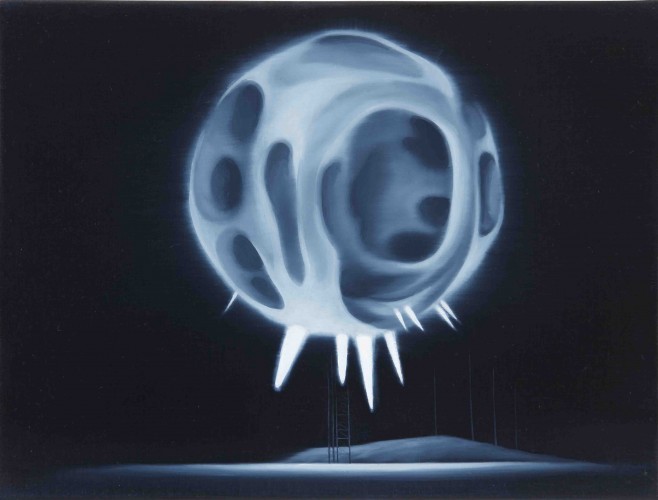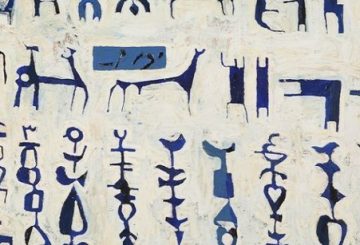Sydney-based artist Sam Leach has curated Extropians, a new show at Sullivan & Strumpf Fine Art. The exhibitions brings together a group of artists whose work suggests ambiguous science fictional narratives. Leach spoke to the Art Life about the ideas and themes behind the title.
What is an “extropian”?
Sam Leach: Extropians are people who believe that progress in science and technology means that humans will soon achieve some kind of immortality. The term derives from extropy – not quite, but almost, the opposite of entropy – it refers to the idea that life and intelligence will expand in an orderly way throughout the universe. The extropian view is sort of an extreme optimism about the future. I’m not totally convinced they are right, but I do like technology and I really like the optimism.

Tony Lloyd, Unique Form of Continuity in Space Time, 2009.
Oil on linen, 23x30cms.
Perhaps you could talk about the selection of works for the show – what were you looking for when you selected the artists and their paintings?
SL: I wanted works which addressed the relationship between humans and technology and I tried to think about that in a broadest sense. So there are paintings which have technology as their subject matter, as with Tony Lloyd and Giles Alexander. There are paintings in which painting itself is represented as a transformative technology as with Stephan Balleux. The show really emerged after seeing some works by Topologies (Donna Kendrigan and Chris Henschke) and, quite soon after, a show by Charles O’Loughlin. Topologies create objects which seem to appeal to a nostalgia for an historical form of futurism – beautifully crafted wood and brass instruments which present quite sophisticated optical illusions with scientific themes. Their works do not unreservedly celebrate science but they do set up a very romantic view of technology. In O’Loughlin’s work data analysis based on his own social interactions is used to generate charts which the form the basis of his abstract paintings. Ultimately he aims to gather enough data to be able to forecast his own life. I could sense some connection between these works and when I came across the extropians it began to fall into place. O’Loughlin’s wildly ambitious plans for his data – not to mention his use of his entire life in the cause of data collection – was related to the scientific heroism hinted at in Topologies’ work. The final piece fell into place with Michael Graeve and Toshiya Tsunoda. In their works technology is already being used to extend perception beyond the limits of “natural” or un-augmented human abilities.
It’s interesting looking at the contrast between the works seen individually and then as a group. Taken individually, the paintings work in a realist mode and might suggest an ambiguous narrative, together they have a very science fictional feel, as though the exhibition works together as an overall narrative – was that your aim?
A proper geek would prefer the term speculative fiction. Yes, I do think the paintings and the especially the piece by Topologies have that feel. I love science fiction so it is probably not a coincidence that the art that appeals to me has some hint of that too. I did try to create the possibility for narrative by including works which hinted at history (Lloyd, Topologies), works which engage the viewer with the present (Graeve, Tsunoda) and works which hint at futures both near and distant (Lloyd again, Balleux, Alexander). Many of the works cover several of those at once, of course, so it is not as though it unfolds like a comic strip. In the best traditions of hard science fiction, multiple realities and timelines co-exist.
The term “speculative fiction” was coined by Robert Heinlein, who liked to call it “spec-fic” – but it seems the term has been subsumed back into the greater generic name “science fiction” – do you see a difference between the two terms? And how does that relate to the show?
SL: The term has drifted in and out of use for quite a while. Fans of this genre do tend to be enthusiastic so there are many thousands of internet pages devoted to discussing the nuances of these terms. For my two cents, I tend to think of speculative fiction as a slightly better description of the genre and a bit broader than than science fiction. Some of the most interesting books do not really go into science at all but look at alternate histories or social structures – Hesse‘s Glass Bead Game, Philip K Dick and Neal Stephenson spring to mind. In this show, with one or two exceptions, there is no reference to any actual science. The works deal with the relationship between humans and technology without getting too bogged down in the actual gear mechanisms.

Charles O’Loughlin, September, 2009.
Gouache on paper, 49x45cms.
The imagery of science fiction tends towards a decidedly realist mode of image making – yet you’ve also included abstract works such as Charles O’Loughlin’s mandala-like ‘September’. Was there something in that juxtaposition that interested you?
SL: Absolutely. In the same way that I wanted works which specifically addressed the future, present and past I also wanted to look at artists who used a wide variety of modes in their work. O’Loughlin’s practice verges on performance. His works are really charts which present information, month by month, about who he meets, where and how often. When a painting of a graph is shown, or even several of them, it is really only a tiny fragment of his overall work, which presumably won’t be finished until he is dead or gives up. Or both. The paintings are presented together with books of coded data. Literally thousands of pages of the stuff. They hint at what these apparently abstract paintings represent but they are absolutely no help at all in recovering any kind of meaningful information from the charts. Where the realist paintings have a science fiction feel, O’Loughlin’s work feels closer to the way imagery is actually used in contemporary science – mostly for the graphic display of statistical information (and mostly unintelligible to all but the authors).
![]()
Joanna Lamb, High Rise 8, 2009.
Acrylic on canvas, 170x120cms.
From the companion exhibition High Rise.
Joanna Lamb’s latest paintings are also on show at Sullivan & Strumpf and seem like a very natural continuation of what you’re talking about. The title of her show Highriseseems to be a direct reference to J.G. Ballard, whose spirit is very much present in your show too. Was putting the two exhibitions together intentional?
SL: Funny you should mention that because I spent the weekend installing a rainwater tank and Ballard was never far from my mind. Sullivan and Strumpf will have to take the credit for bringing the two shows together. It is a really great juxtaposition. Ballard consistently asked questions about the way that technology and especially urban development might impact the human psyche. The extropians themselves seem pretty unconcerned about the possible psychological implications of extreme longevity or technological augmentation of the human. Or perhaps it would be more accurate to say that they are optimistic about the implications. The image of the highrise perfectually captures the moment of transition between utopian vision and dystopian delivery, especially as it is shown in Lamb’s paintings with their idealised clean, hard edges and disturbing acidic colours. Since my show is upstairs from the highrise, maybe it could be thought of as a sort of tech version of the blood garden!

Giles Alexander, 1180 AD, House of God, 2009.
Oil and resin on canvas, 65x105cms.
You’ve often included technological objects in your own painting – how do you see your own work relating to the show?
SL: To be honest the show is a massive indulgence for me. I love the aesthetics of science and technology and to some extent this show could be subtitled “ideas I wish I’d had” or “works I wish I’d made”. The themes of nature and technology are important for me but the relationship between humans and animals is of equal importance. This show allowed me to really get stuck directly into the human/technology relationship via the entertainingly extreme position of the extropians. The other thing is that my own practice is primarily painting – trying to paint well is a very time consuming process and doesn’t leave a lot of room to engage with other modes of artistic production even though I am very interested in them. So it is great to be able to look at the themes and ideas I am interested in using objects, installation and sound works. Even if someone else made them.
Extropians, curated by Sam Leach, and High Rise by Joanna Lamb are at Sullivan & Strumpf, Paddington until December 13.

